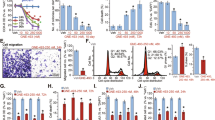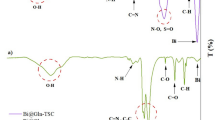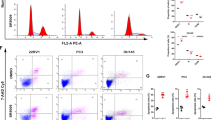Abstract
To determine the effects of glutathione-S-transferase π (GSTπ) on the actions of As2O3, As2O3-induced growth inhibition and apoptosis was studied in three prostate cancer cell lines: DU-145, PC-3 and LNCaP cells. As2O3 inhibited cell proliferation of DU-145 and PC-3 cells (both cells express GSTπ), but not of LNCaP cells (which lack GSTπ expression) at concentrations below 1 μ M. LNCaP cells stably transfected and expressed GSTπ (LNCaP/GSTπ) became sensitive to As2O3 growth inhibition. As2O3 arrested cell growth of DU-145, PC-3 and LNCaP/GSTπ cells in the G2/M phase of the cell cycle at low concentrations (<2 μ M), but did not induce apoptosis. At higher concentrations (10–20 μ M), As2O3 induced apoptosis in LNCaP cells, but not in DU-145 or PC-3 cells. The apoptosis induction due to As2O3 treatment of LNCaP cell correlated with the activation of JNK and p38 and induction of p53 protein. LNCaP/GSTπ cells became insensitive to As2O3-induced apoptosis with reduced JNK activition. These data indicate that GSTπ increases growth inhibition due to As2O3 treatment and prevents As2O3-induced apoptosis in prostate cancer cells. Therefore, it appears that As2O3 inhibits cell growth and induces apoptosis through different mechanisms.
This is a preview of subscription content, access via your institution
Access options
Subscribe to this journal
Receive 50 print issues and online access
$259.00 per year
only $5.18 per issue
Buy this article
- Purchase on Springer Link
- Instant access to full article PDF
Prices may be subject to local taxes which are calculated during checkout










Similar content being viewed by others
References
Adler V, Yin Z, Fuchs SY, Benezra M, Rosario L, Tew KD, Pincus MR, Sardana M, Henderson CJ, Wolf CR, Davis RJ and Ronai Z . (1999). EMBO J., 18, 1321–1334.
Blagosklonny MV . (2002). Int. J. Cancer, 98, 161–166.
Bode A and Dong Z . (2000). Drug Resist. Update, 3, 21–29.
Chen GQ, Shi XG, Tang W, Xiong SM, Zhu J, Cai X, Han ZG, Ni JH, Shi GY, Jia PM, Liu MM, He KL, Niu C, Ma J, Zhang P, Zhang TD, Paul P, Naoe T, Kitamura K, Miller W, Waxman S, Wang ZY, de The H, Chen SJ and Chen Z . (1997). Blood, 89, 3345–3353.
Chen GQ, Zhou L, Styblo M, Walton F, Jing Y, Weinberg R, Chen Z and Waxman S . (2003). Cancer Res., 63, 1853–1859.
Chen YC, Lin-Shiau SY and Lin JK . (1998). J. Cell Physiol., 177, 324–333.
Cookson MS, Reuter VE, Linkov I and Fair WR . (1997). J. Urol., 157, 673–676.
Dai J, Weinberg RS, Waxman S and Jing Y . (1999). Blood, 93, 268–277.
Gurr JR, Bau DT, Liu F, Lynn S and Jan KY . (1999). Mol. Pharmacol., 56, 102–109.
Huang C, Ma WY, Li J, Goranson A and Dong Z . (1999). J. Biol. Chem., 274, 14595–14601.
Huang MJ, Hsieh RK, Lin CP, Chang IY and Liu HJ . (2002). Leuk. Lymphoma, 43, 2191–2199.
Iwama K, Nakajo S, Aiuchi T and Nakaya K . (2001). Int. J. Cancer, 92, 518–526.
Jing Y, Dai J, Chalmers-Redman RM, Tatton WG and Waxman S . (1999). Blood, 94, 2102–2111.
Jing Y, Waxman S and Mira-y-Lopez R . (1997). Cancer Res., 57, 1668–1672.
Lee WH, Morton RA, Epstein JI, Brooks JD, Campbell PA, Bova GS, Hsieh WS, Isaacs WB and Nelson WG . (1994). Proc. Natl. Acad. Sci. USA, 91, 11733–11737.
Leszczyniecka M, Kang DC, Sarkar D, Su ZZ, Holmes M, Valerie K and Fisher PB . (2002). Proc. Natl. Acad. Sci. USA, 99, 16636–16641.
Lin X, Tascilar M, Lee WH, Vles WJ, Lee BH, Veeraswamy R, Asgari K, Freije D, van Rees B, Gage WR, Bova GS, Isaacs WB, Brooks JD, DeWeese TL, De Marzo AM and Nelson WG . (2001). Am. J. Pathol., 159, 1815–1826.
Liu J, Chen H, Miller DS, Saavedra JE, Keefer LK, Johnson DR, Klaassen CD and Waalkes MP . (2001). Mol. Pharmacol., 60, 302–309.
Liu Y, Guyton KZ, Gorospe M, Xu Q, Lee JC and Holbrook NJ . (1996). Free Radic. Biol. Med., 21, 771–781.
Lo JF, Wang HF, Tam MF and Lee TC . (1992). Biochem. J., 288 (Part 3), 977–982.
Ludwig S, Hoffmeyer A, Goebeler M, Kilian K, Hafner H, Neufeld B, Han J and Rapp UR . (1998). J. Biol. Chem., 273, 1917–1922.
Moskaluk CA, Duray PH, Cowan KH, Linehan M and Merino MJ . (1997). Cancer, 79, 1595–1599.
Park JW, Choi YJ, Jang MA, Baek SH, Lim JH, Passaniti T and Kwon TK . (2001). Biochem. Biophys. Res. Commun., 286, 726–734.
Polek TC, Stewart LV, Ryu EJ, Cohen MB, Allegretto EA and Weigel NL . (2003). Endocrinology, 144, 50–60.
Samet JM, Graves LM, Quay J, Dailey LA, Devlin RB, Ghio AJ, Wu W, Bromberg PA and Reed W . (1998). Am. J. Physiol., 275, L551–L558.
Shao W, Fanelli M, Ferrara FF, Riccioni R, Rosenauer A, Davison K, Lamph WW, Waxman S, Pelicci PG, Lo Coco F, Avvisati G, Testa U, Peschle C, Gambacorti-Passerini C, Nervi C and Miller Jr WH . (1998). J. Natl. Cancer Inst., 90, 124–133.
Shen ZX, Chen GQ, Ni JH, Li XS, Xiong SM, Qiu QY, Zhu J, Tang W, Sun GL, Yang KQ, Chen Y, Zhou L, Fang ZW, Wang YT, Ma J, Zhang P, Zhang TD, Chen SJ, Chen Z and Wang ZY . (1997). Blood, 89, 3354–3360.
Soignet SL, Maslak P, Wang ZG, Jhanwar S, Calleja E, Dardashti LJ, Corso D, DeBlasio A, Gabrilove J, Scheinberg DA, Pandolfi PP and Warrell Jr RP . (1998). N. Engl. J. Med., 339, 1341–1348.
Styblo M, Del Razo LM, Vega L, Germolec DR, LeCluyse EL, Hamilton GA, Reed W, Wang C, Cullen WR and Thomas DJ . (2000). Arch. Toxicol., 74, 289–299.
Styblo M, Drobna Z, Jaspers I, Lin S and Thomas DJ . (2002). Environ. Health Perspect., 110 (Suppl 5), 767–771.
Wang HF and Lee TC . (1993). Biochem. Biophys. Res. Commun., 192, 1093–1099.
Wang T, Arifoglu P, Ronai Z and Tew KD . (2001). J. Biol. Chem., 276, 20999–21003.
Wang Z, Dey S, Rosen BP and Rossman TG . (1996). Toxicol. Appl. Pharmacol., 137, 112–119.
Wu GS, Saftig P, Peters C and El-Deiry WS . (1998). Oncogene, 16, 2177–2183.
Yang CH, Kuo ML, Chen JC and Chen YC . (1999). Br. J. Cancer, 81, 796–799.
Yin Z, Ivanov VN, Habelhah H, Tew K and Ronai Z . (2000). Cancer Res., 60, 4053–4057.
Acknowledgements
This work was partly supported by NIH Grants CA93533 and CA85478, and Samuel Waxman Cancer Research Foundation.
Author information
Authors and Affiliations
Corresponding author
Rights and permissions
About this article
Cite this article
Lu, M., Xia, L., Luo, D. et al. Dual effects of glutathione-S-transferase π on As2O3 action in prostate cancer cells: enhancement of growth inhibition and inhibition of apoptosis. Oncogene 23, 3945–3952 (2004). https://doi.org/10.1038/sj.onc.1207500
Received:
Revised:
Accepted:
Published:
Issue Date:
DOI: https://doi.org/10.1038/sj.onc.1207500
Keywords
This article is cited by
-
Epigenetic alterations in TRAMP mice: epigenome DNA methylation profiling using MeDIP-seq
Cell & Bioscience (2018)
-
shRNA-mediated GSTP1 gene silencing enhances androgen-independent cell line DU145 chemosensitivity
International Urology and Nephrology (2014)
-
Redox status of thioredoxin-1 (TRX1) determines the sensitivity of human liver carcinoma cells (HepG2) to arsenic trioxide-induced cell death
Cell Research (2008)
-
Human glutathione S-transferase P1-1 interacts with TRAF2 and regulates TRAF2–ASK1 signals
Oncogene (2006)



